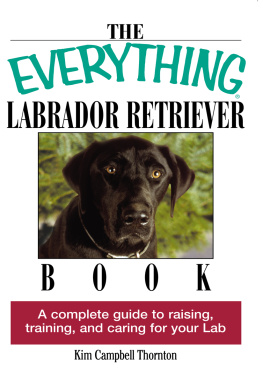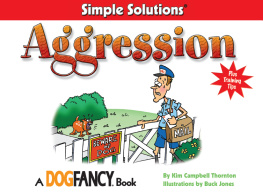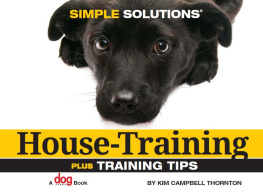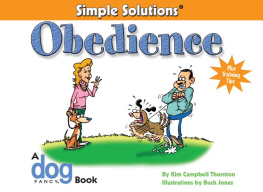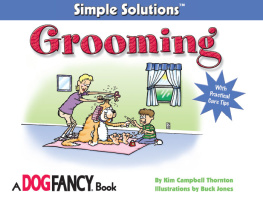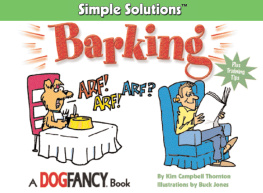Ruth Strother, Project Manager
Nick Clemente, Special Consultant
Michelle Martinez, Karla Austin, Editors
Michael Vincent Capozzi, Designer
Copyright 2002 by I-5 Press
Illustrations copyright 2002 by Buck Jones
The dogs in this book are referred to as he and she in alternating chapters.
All rights reserved. No part of this book may be reproduced, stored in a retrieval system, or transmitted in any form or by any means, electronic, mechanical, photocopying, recording, or otherwise, without the prior written permission of I-5 Press, except for the inclusion of brief quotations in an acknowledged review.
Library of Congress Cataloging-in-Publication Data
Thornton, Kim Campbell
Digging / by Kim Campbell Thornton ; illustrations by Buck Jones.
p. cm.
ISBN 1-889540-95-1 (pbk. : alk. paper)
eISBN: 9781620080672
1. Dogs--Behavior. 2. Dogs--Training. I. Title
SF433 .T53 2002
636.7'0887--dc21
2002004410
I-5 Press
A Division of I-5 Publishing, LLC
3 Burroughs
Irvine, California 92618
Printed and Bound in Singapore
10 9 8 7 6 5 4 3 2 1
Contents
Why Do Dogs Dig?
Are they digging to China? Looking for buried treasure? Conducting an archaeological excavation? Preparing a foundation for a new doghouse? As obsessively as some dogs dig, it certainly seems as if they must have some higher purpose for digging.
Digging is a perfectly normal behavior for dogs. Your rottweiler, Scottie, or husky isnt digging to make you angry, hes just doing what comes naturally. Some dogs are born to dig, especially the terriers, who were bred to seek out underground prey such as moles, foxes, and badgers, and the Nordic breeds, whose ancestors dug snow caves to keep warm in the frozen wastes of their homeland. Digging is a remnant of the survival skills needed by ancient dogs. Before dogs became domesticated, they dug to store or find food and to create shelter for themselves and their pups. When you see your dog dig, youre watching heredity in action.


When not given other activities to occupy their minds, terriers and herding, working, or sporting dogs will dig. After all, these are dogs who were bred to have a mission, whether that was to go on rodent search-and-destroy missions, seek out and retrieve game, pull sleds or carts, herd livestock, or stand guard. They need to have a job, and if they arent given one, well, digging will have to do.
Some dogs dig simply to mimic their owners whom they see playing in the dirt while gardening or doing yard work. Digging is good exercise too. Its a great workout for a dogs upper body and legs. We do aerobics, dogs dig.
Among the reasons dogs dig, entertainment, prey, shelter, attention, anxiety, and escape are the more popular. But there is a reason that dogs dont dig, and thats for spite. We often think that Max has dug up the yard out of revenge because we dont spend enough time with him, but, dogs just arent programmed that way. While theyre pretty darn smart, they arent capable of thinking, Ill teach him to leave me alone for twelve hours straight. Ill dig a hole the size of a swimming pool! The belief that dogs do things to get back at us is a myth that should have long since been retired.

Just because digging is normal, however, doesnt always make it acceptable. Excessive or inappropriate digging can damage or destroy yards, gardens, carpets, doors, and walls. And a dog who escapes the yard by digging is exposed to such hazards as being hit by a car, attacked by another dog, or shot by an irate neighbor, not to mention the possibilities of unwanted pregnancies or contagious diseases.
How can you stop, or at least channel, digging so that its less destructive? Study the reasons for digging in the following chapters and ask yourself whether any of them apply to your dog. Once youve determined why Digger Dan behaves the way he does, you can use the suggestions in this book to solve your digging problem.
Digging for Fun
Digging is a lot of fun for dogs. If you think about it, a dogs digging behavior is similar to a childs enjoyment of making mud pies or finger painting. Dirt smells good when its dug up, and tree roots can take the place of a tug toy, with the tree holding the other end of the toy.
Dogs often dig for entertainment when they spend a lot of time alone in a yard, especially if theyre left without toys. Puppies and young dogs up to three years of age dig for fun when they dont have other outlets for their energy such as regular exercise and playtime.

If your dog digs for fun, you can often redirect her energy by spending more time with her, giving her more exercise, and providing her with interesting toys. A half hour walk once or twice a day helps your dog expend excess energy, plus its good exercise for you too!
Puppies need even more exercise. Take yours for onleash walks at least four times a day (after meals and naps) and provide a couple of playtime sessions in your backyard if its fenced so she can run off leash. Remember, just because your dog has a big yard doesnt mean she will exercise herself. Just like us, dogs need motivation, and in most cases that motivation is the presence of their people.
Dogs enjoy playing with their owners. Take some time every day to play with your dog by tossing a ball or flying disc, playing tug, or practicing tricks or agility routines. Take an obedience class with your dog and practice the commands you learn every day, but practice for only a few minutes at a stretch. You want your dog tired, not wired.

When you cant be there to play with your dog, make sure she has several interesting toys to keep her occupied. Good choices include Kongs or Giggle Balls that are stuffed with treats, and balls of different sizes that can be rolled around the yard. Tennis balls, soccer balls, and basketballs are good choices, depending on the type of dog you have. Rotate toys so your dog always has something different to play with.
If you feed dry kibble, make your dog work for her meals. In the morning, before you leave for work, fill a Buster Cube or similar toy with the amount of food your dog gets for breakfast. The hole releases the food as the dog rolls the toy. This is your dogs big chance to hunt for her food instead of having it handed to her in a silver dog dish. The activity will keep her too busy to dig.
Provide an area where its okay to dig and teach your dog to use it. A remote area of the yard, or any place you dont mind a few holes, is a good start. Decide on an area and allot about four square feet. Shady areas are good choices as they help your dog stay cool. A childs sandbox or a plastic wading pool are also good alternatives. Some people prefer sand because it doesnt turn into mud when it gets wet, and its easy for the dog to shake off.
When you have decided on a digging area, cover it with about two feet of sand or loose soil. You can define or disguise the area by surrounding it with rocks, shrubs, two-by-fours, railroad ties, or even a low decorative fence. (Keep in mind that sandy, shady areas can attract fleas. Keep them at bay by mixing small amounts of diatomaceous earth (DE) in with the sand. Be careful not to breathe in the DE dust.)
Next page

